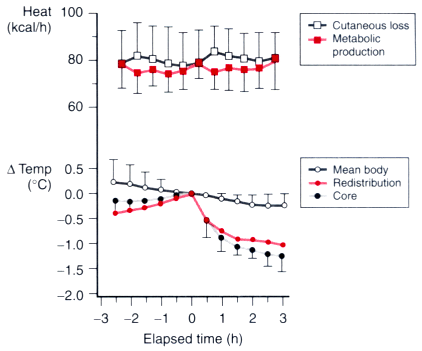 |
 |
Figure 40-16
Overall, heat balance was only slightly negative (loss
exceeding production) before induction of anesthesia and subsequently changed little.
To separate the contributions of decreased overall heat balance and internal redistribution
of body heat to the decrease in core temperature, the change in overall heat balance
was divided by body weight and the specific heat of humans. The resulting change
in mean body temperature ("mean body") was subtracted from the change in core temperature
("core"), thus leaving the core hypothermia specifically resulting from redistribution
("redistribution"). After 1 hour of anesthesia, core temperature had decreased 0.8°C
± 0.3°C, with redistribution contributing 89% to the decrease.
During the subsequent 2 hours of anesthesia, core temperature decreased an additional
0.4°C ± 0.3°C, with redistribution contributing
62%. Redistribution thus contributed 80% to the entire 1.2°C ±
0.3°C decrease in core temperature during the 3 hours of anesthesia.
The increase in the "redistribution" curve before induction of anesthesia indicates
that thermoregulatory vasoconstriction was constraining metabolic heat to the core
thermal compartment. Such constraint is, of course, the only way in which core temperature
could increase while body heat content decreased. Induction of epidural anesthesia
is identified as elapsed time zero. Results are presented as means ± SD.
(Redrawn with modification from Matsukawa T, Sessler DI, Christensen R,
et al: Heat flow and distribution during epidural anesthesia. Anesthesiology 83:961–967,
1995.)

 |
